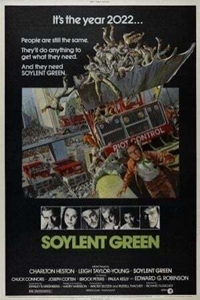Soylent Green (PG) ★★★
 Spoilers! (Although the movie is 46 years old)
Spoilers! (Although the movie is 46 years old)
Soylent Green represents the last film in Charlton Heston's unofficial post-apocalyptic trilogy, following Planet of the Apes (1968) and The Omega Man (1971). After this, he would move onto other things, including the newly-popular disaster movie genre. A dark, dystopian science fiction story where (unwitting) cannibalism is the means of survival, Soylent Green is the bleakest of the three films by a long stretch. Although the structure is designed to mimic that of a standard police procedural, the movie is really about the ugly side of human nature.
Soylent Green is set in the year 2022. Now that we have nearly reached that year, it's possible to see where the film's predictive capabilities have succeeded. According to the backstory, overpopulation has become a crippling problem for the planet, leading to food shortages and mass poverty. New York City alone has 40 million inhabitants. In concert with the explosion in births, Global Warming resulting from a buildup of greenhouse gasses has all-but-eliminated traditional supplies of foodstuffs. People subsist on synthetic products like "Soylent Red," "Soylent Yellow," and the new, ballyhooed "Soylent Green" -- consumables that are filling, nutritious, and tasteless. Soylent Green is said to have been synthesized from sea enzymes and, as a result, is high in protein.
After existing in a virtually empty futuristic world in The Omega Man, Charlton Heston finds himself in an overcrowded one in Soylent Green. As police officer Thorn, he is accorded certain privileges. He shares an apartment with his aging partner, Sol Roth (Edward G. Robinson), who has devised a way to maintain electricity by peddling a bicycle. Their home is small and cramped but it's a lot more luxurious than what many people have. To ascend the stairs to his front door, Thorn has to climb over the people who have staked out spaces on the stairwell to sleep. Director Richard Fleischer's vision of the future is claustrophobic and dirty -- technology hasn't advanced past the 1970s and people aren't living much better than animals. If it was remade today, Soylent Green would use state-of-the-art special effects to create the decaying New York. Fleischer did this without CGI, using old-fashioned filmmaking techniques that are singularly effective because of their realism.
Soylent Green follows Thorn's investigation into the murder of a wealthy businessman, William R. Simonson (Joseph Cotton). After examining the crime scene and interviewing witnesses -- including the dead man's mistress/sex slave, Shirl (Leigh Taylor-Young), and bodyguard, Tab Fielding (Chuck Connors) -- Thorn determines that Simonson was assassinated. After he presents this conclusion to his chief (Brock Peters), he is told to close the case. When he refuses, an attempt is made on his life. Meanwhile, Sol uncovers the truth behind Simonson's death and, despairing about the future of humanity, decides on euthanasia as the most agreeable option. Before dying, he passes on his suspicions to Thorn, who uncovers proof that "Soylent Green is people" (synthesized from the remains of the euthanized) just before being seriously wounded in a shoot-out. Although his chief promises to make this known to the public, we suspect that the truth will remain what it has always been: a carefully-guarded secret that powerful people will kill to protect.
Screenwriter Stanley Greenberg adapted a Harry Harrison novel for his script but at times went far afield from the source material. Two of the best-remembered (and arguably, the most controversial) elements of Soylent Green were devised by Greenberg: the cannibalism forced unknowingly on the starving masses and the concept of women selling themselves as "furniture" for a chance at a more comfortable life. Although basically sex slaves, women like Shirl, with whom Thorn develops a romantic relationship, are willing to submit to the whims of the men who rent the apartments in exchange for hot water, working air conditioning, real food, and video games.
The world-building of Fleischer and Greenberg is strong. Their representation of a future Earth devastated by global warming and runaway population growth is grim and believable. The rich are shown to enjoy privileged existences while life has become burdensome for 99% of the population. Men like Simonson can afford strawberry jam, real beef, and apples, but those luxuries are beyond the affordability of most people. When Thorn obtains some, after pilfering them from the dead man's apartment (as apparently is typical for police officers), Sol is overcome with emotion, remembering when such things were commonplace.
At times, Soylent Green feels dated. The most obvious example is the fight scenes, which are badly choreographed and clumsily executed. The fist-fight between Heston and Chuck Connors is almost laughable. Action scenes in general were handled differently during the 1970s; Fleischer doesn't show any particular aptitude in this area -- only at the end of his career did he embrace the action/adventure genre with duds like Conan the Destroyer and Red Sonja. Prior to Soylent Green, he was best known for Fantastic Voyage and Doctor Dolittle.
With one exception, the acting in Soylent Green is pedestrian. Charlton Heston veers from wooden to over-the-top in a style that would categorize most of his performances during the ‘70s. More of a star than an actor throughout his career, he proved unable to compensate for the downward trajectory of his popularity. Soylent Green was the final film for Edward G. Robinson, whose distinguished career extended all the way back to the early talkies. His best-known movies included Little Caesar, Double Indemnity, and Key Largo (one of five films he made with Humphrey Bogart). He died 12 days after completing Soylent Green; the last time he appeared before a camera was to film his own death scene. The sequence, already moving due to how Robinson plays it, gains additional poignance when one considers the story behind it.
Although Soylent Green cannot be fully lauded for its ability to predict the future, its prescience about the effects of Global Warming is unsettling. The film as a whole is uneven; its science fiction elements are intriguing but the murder mystery investigation is uninteresting at best and tedious at worst. Nevertheless, Soylent Green invents a compelling world and populates it with details that make it feel more lived-in than many futuristic compositions. And, while the ending is sufficiently well-known to remove any shock factor from its unveiling, it's easy to see how audiences might have been horrified to learn the truth about Soylent Green nearly fifty years ago.
© 2019 James Berardinelli
To get the full Quicklook Films experience, uncheck "Enable on this Site" from Adblock Plus
box office top 10

Challengers Released: April 26, 2024 Cast: Zendaya, Josh O'Connor 15M

Unsung Hero Released: April 26, 2024 Cast: Daisy Betts, Joel Smallbone 7.8M

Godzilla x Kong: The New Empire Released: March 29, 2024 Cast: Rebecca Hall, Brian Tyree Henry 7.2M

Civil War Released: April 12, 2024 Cast: Kirsten Dunst, Wagner Moura 7M

Abigail Released: April 19, 2024 Cast: Melissa Barrera, Dan Stevens 5.3M

The Ministry of Ungentlemanly Warfare Released: April 19, 2024 Cast: Henry Cavill, Eiza Gonzalez 3.9M

Kung Fu Panda 4 Released: March 8, 2024 Cast: Jack Black, Viola Davis 3.6M

Ghostbusters: Frozen Empire Released: March 22, 2024 Cast: Paul Rudd, Carrie Coon 3.3M

Dune: Part Two Released: March 1, 2024 Cast: Timothée Chalamet, Rebecca Ferguson 2M

Boy Kills World Released: April 26, 2024 Cast: Bill Skarsgård, Famke Janssen 1.7M






